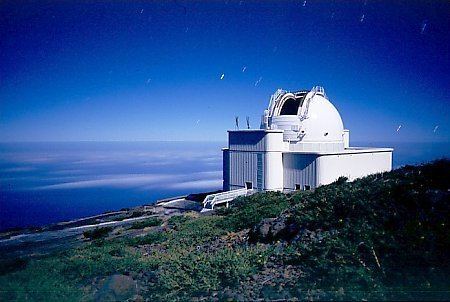Wavelength Optical / infrared | Diameter 2.54 m (100 in) | |
 | ||
Built 1979–1984 (Moved from England) Telescope style Two configurations:Newtonian prime focus (f/3.29)Cassegrain (f/15) | ||
The Isaac Newton Telescope or INT is a 2.54 m (100 in.) optical telescope run by the ING at Roque de los Muchachos Observatory on La Palma in the Canary Islands since 1984.
Contents
Originally it was situated at Herstmonceux Castle in Sussex, England, which was the site of the Royal Greenwich Observatory after it moved away from Greenwich due to light pollution. It was inaugurated in 1967 by Queen Elizabeth II. The telescope is now one member of the Isaac Newton Group of Telescopes.
However, Herstmonceux suffered from poor weather, and the advent of mass air travel made it plausible for UK astronomers to run an overseas observatory. In 1979, the INT was shipped to La Palma, where it has remained ever since. It saw its second first light in 1984, with a video camera.
Today, it is used mostly with the Wide Field Camera (WFC), a four CCD instrument with a field of view of 0.56x0.56 square degrees which was commissioned in 1997. The other main instrument available at the INT is the Intermediate Dispersion Spectrograph (IDS), recently re-introduced having been unavailable for a period of several years.
Technical detail since 1984
The La Palma INT is a Cassegrain telescope, with a 2.54 m (100 in) diameter primary mirror and a focal length of 8.36 m (329 in). The mirror weighs 4361 kg (9614 lb), and is supported by a polar disc/fork type equatorial mounting. The total weight of the telescope is around 90 tons. The f/3.29 Prime focus, used with the WFC, allows an unvignetted field of view of 40 arcminutes (approximately 0.3 square degrees). There is also a secondary focal station, the f/15 Cassegrain focus, which possesses a 20 arcminute field of view and is the mount point for the IDS. The telescopes second first light was done by video.
The pointing accuracy of the telescope is around 5 arcseconds, but a sophisticated autoguider, which tracks a given guide star and makes small corrections to the telescope tracking, allows a guiding accuracy of better than an arcsecond on better than 20th magnitude guide stars in support of the typical 0.8-1.5 arcsec seeing at the INT.
Contemporaries
The Isaac Newton Telescope was a very large telescope for its day, and the largest in England. It was a little smaller in aperture than the 100-inch Hooker telescope in the United States, but much newer. It originally had a 98-inch mirror when in England, but given a new, larger 100-inch mirror by Grubb Parsons after the move. INT locations are Herstmonceux Castle (1967–79) then ORM (1984–).
1967
The INT was inaugurated by Queen Elizabeth II in 1967.
Largest optical telescopes 1967:
1984
INT began its new life atop the Canary Island of La Palma, a Spanish mountain island, in 1984, with a new mirror and dome.
Large visible-light optical ground telescopes in 1984:
